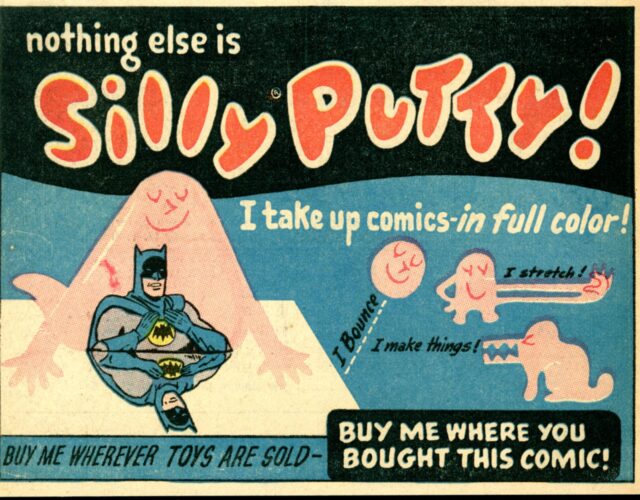Rubber was supposed to end World War II. When Japan invaded Indonesia and other rubber-producing parts of Southeast Asia in 1942, the Allies were cut off from their rubber supply. Tires, gas masks, planes, boats, and tanks required massive amounts of rubber for manufacture and to keep operational. Without rubber the Allies could not compete.
First, the U.S. government asked its citizens for help. Americans donated old raincoats and rubber hoses through scrap drives and rationed their use of tires and other rubber products. But the scrap drives didn’t help much because the recycled rubber did not work nearly as well as the original.
Next the country turned to its scientists to find a synthetic substitute. Although various types of synthetic rubber had been developed since shortages drove research during World War I, none had proved viable. Shortly after the Japanese invasion of Southeast Asia, polymer chemists again ramped up the search for an adequate synthetic.
Two such chemists, Dow Corning’s Earl Warrick and General Electric’s James Wright, experimented with silicone oil. Independently the pair mixed silicone oil with boric acid, creating and later patenting nearly identical compounds. The resulting substance was puzzling. When smashed with a hammer, it broke into hundreds of pieces. Tossed against a wall, it bounced right back. Left alone for a long time, it slowly oozed like a liquid. But apart from bounciness its properties did not mimic those of natural rubber; so both scientists left it to pursue more promising leads.
Neither Warrick nor Wright ever came up with an adequate rubber substitute, a feat accomplished by scientists in U.S. government labs using petroleum. Not much is known about Wright’s career; Warrick went on to design silicone rubber (used in scuba masks) at Dow Corning.
The strange substance made from boric acid and silicone oil quietly stuck around. Over the years the two scientists would entertain their friends with the puttylike polymer. These friends in turn shared it with others, until eventually a sample ended up in the hands of Ruth Fallgatter, a toy-store owner. It remained mostly unknown until 1949, when Fallgatter showed it to an advertising consultant named Peter Hodgson.
Hodgson loved toys and had a good sense of what might appeal to both adults and children. When Fallgatter stopped carrying what she called “bouncing putty,” Hodgson jumped at the opportunity. He borrowed money to pay for a shipment of putty from the General Electric lab where Wright had first made it and bought the production rights. Hodgson renamed it Silly Putty and sold it in one-ounce portions inside small plastic eggs in time for Easter in 1950. The putty sold modestly at first, though eventually Hodgson convinced Doubleday and Nieman-Marcus bookstores to stock it.
Silly Putty defies traditional expectations of how substances behave. Apply a lot of force in a short amount of time, and it’s a brittle solid. Pull it apart gradually, and it’s a slow-moving liquid. It belongs to a category of matter called non-Newtonian fluids. Other examples with less pronounced effects include blood, ketchup, and toothpaste.
Hodgson caught his big break when a New Yorker reporter went to a Doubleday bookstore to pick up a book and instead found Silly Putty. The reporter wrote a short article praising Hodgson and his toy in the August 26, 1950, issue of the magazine. Suddenly everyone in the country had to have Silly Putty. Within a year Hodgson had sold millions of his plastic eggs, and annual sales went on to exceed $5 million in the 1970s. Television ads further cemented the toy as a national phenomenon.
Why did a blob of goo become one of the most popular toys for children and adults in the 1950s? For Hodgson, Silly Putty offered a release from emotional stress. “It means five minutes of escape from neurosis. It means not having to worry about Korea or family difficulties,” Hodgson told the New Yorker. Spread Silly Putty on a newspaper and the ink sticks to it, the text mirrored. Pull and stretch the putty, and the headlines wiggle and zigzag. Silly Putty is a toylike artifact from an era in need of distraction.
Hodgson became a millionaire by creating a market for a product he did not invent, while Warrick and Wright spent years arguing over who first combined silicone oil and boric acid. If, as with many inventions, the U.S. Patent Office casts the deciding vote, then Warrick is the winner. He applied for a patent in 1943, a year before Wright submitted his application. But Silly Putty made neither man rich. Warrick, as a Dow Corning employee, received $1 for his patent.
Hodgson was determined to bring his toy to the entire world. In 1961, right in the middle of the Cold War, he traveled to the Soviet Union. The Soviets thought Hodgson was an illusionist until he let people touch the stuff. But what amazed them the most was not the putty’s characteristics but the fact that it was produced at all, and in large quantities. “They were fascinated that something that was utterly useless was being manufactured,” Hodgson’s son later recalled. Still, the toy sold well in the Soviet Union.
Silly Putty eventually found more practical uses. According to a 1990 New York Times article it has the same density as human flesh, and for a time doctors used it to safely test and align X-ray computed tomography machines. The substance’s unique properties also mimic the plasticity of plate tectonics: geologists can show students how the earth’s crust moves using models made from Silly Putty.
The toy that proved popular with adults as a stress reliever even joined the space race. The Apollo 8 astronauts carried Silly Putty in sterling-silver eggs on their 1968 lunar orbit.




